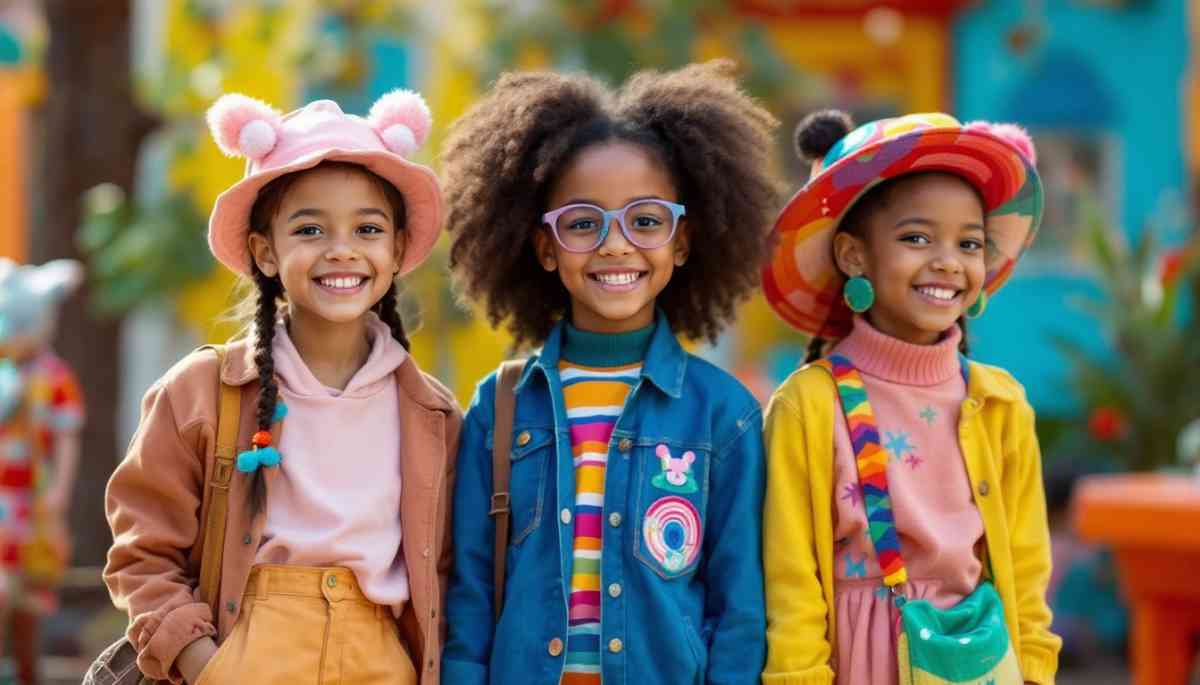We fashion kinder is not just about clothing; it encompasses identity, expression, and cultural significance, especially in the formative years of childhood. Children often mimic what they see, and that includes the fashions they encounter in their families, on television, and through their peers. The world of children’s fashion is vibrant and ever-evolving, reflecting broader societal trends while also celebrating individuality.
Understanding the Importance of Fashion in Childhood Development
Clothing serves as a fundamental means of expression for children. It allows them to experiment with their identities, showcasing personal style and individuality. Understanding the importance of fashion in childhood development means recognizing that what children wear can influence their social interactions, self-esteem, and even their academic performance.
The choices children make regarding their clothing can offer insightful glimpses into their personalities. When children pick out their outfits, they engage in decision-making processes that are crucial for their cognitive and emotional development. Moreover, feeling good in their clothes can enhance their confidence, encouraging them to express themselves more freely and interact positively with their peers.
Additionally, fashion can play a significant role in fostering creativity and imagination. Children often draw inspiration from various sources, such as cartoons, movies, or even their favorite characters, which can lead to unique outfit combinations that reflect their interests and passions. This creative expression through clothing can stimulate their artistic abilities and encourage them to think outside the box, further enriching their developmental journey.
Furthermore, the social aspect of fashion cannot be overlooked. As children grow, they become increasingly aware of their surroundings and the opinions of others. Fashion can serve as a social tool, helping them to fit in with peer groups or stand out in a crowd. This dynamic can teach valuable lessons about acceptance, diversity, and the importance of respecting different styles and choices. By navigating these social landscapes, children learn to develop empathy and understanding, which are essential skills for their future interactions in a diverse world.
Trends in Children’s Fashion: What’s Hot Right Now
As with any fashion sector, children’s clothing trends often change rapidly. Currently, several trends are emerging in the realm of children’s fashion, making it an exciting area for parents and guardians to explore.
- Gender-Neutral Clothing: Many brands are embracing and promoting gender-neutral options, allowing children to choose styles that truly resonate with them. This shift not only empowers children to express their individuality but also encourages inclusivity and acceptance from a young age.
- Tech-Infused Fashion: Interactive clothing, including garments with built-in LEDs or temperature control, are becoming popular among the tech-savvy youth. These innovations not only add a fun element to dressing but also enhance functionality, making outfits adaptable for various activities, whether it’s a day at school or a weekend adventure.
- Vintage and Retro Styles: Nostalgia is sweeping the fashion world. Parents are dressing their children in items reminiscent of the 70s, 80s, and 90s. This trend allows families to bond over shared memories while introducing children to styles that have stood the test of time, creating a unique blend of past and present.
Staying updated with children’s fashion trends can be both fun and practical, allowing parents to navigate the market more effectively while considering their child’s preferences. Furthermore, the rise of sustainable fashion is influencing children’s clothing choices, with many parents opting for eco-friendly brands that prioritize ethical production methods. This not only teaches children the importance of caring for the environment but also encourages them to make thoughtful choices about their clothing from an early age.
Another trend gaining traction is the emphasis on comfort and functionality. With children leading active lives, clothing that allows for movement and play is essential. Brands are now focusing on creating versatile pieces that can transition from school to playdates seamlessly, ensuring that children feel comfortable and confident in their outfits. This practicality is particularly appealing to parents who want to invest in durable clothing that can withstand the rigors of childhood while still being stylish.
Sustainable Fashion Choices for Kids: A Parent’s Guide
As environmental concerns continue to rise, sustainable fashion choices for children are becoming essential. Parents today are more aware of the impact their purchases can have on the planet. Sustainable fashion not only nurtures the environment but also teaches children the importance of eco-consciousness.
- Choosing Organic Materials: Look for clothing made from organic cotton or bamboo, which are not only sustainable but also gentle on a child’s skin.
- Second-Hand Shopping: Thrift stores and online exchanges provide opportunities to find unique pieces while reducing waste.
- Encouraging DIY Projects: Engaging children in DIY clothing projects can add a personal touch to their wardrobes and instill a sense of value in their garments.
Making sustainable choices doesn’t have to be restrictive. Rather, it opens doors for creativity and deeper conversations about personal responsibility towards nature. For instance, when children participate in the selection of their clothing, they learn to appreciate the stories behind each item, whether it’s a vintage find or a handmade piece. This understanding can foster a sense of connection not only to their clothing but also to the broader community and the environment.
Additionally, parents can introduce their children to brands that prioritize ethical production practices, ensuring fair wages and safe working conditions for garment workers. By supporting these brands, families can contribute to a more equitable fashion industry. Discussing these choices with children can empower them to think critically about consumerism and the importance of supporting companies that align with their values. This awareness can lead to a generation that not only cares about style but also about the impact of their fashion choices on the world around them.
How to Encourage Creativity Through Children’s Clothing
Clothing can serve as a canvas for children’s creativity. Parents can help foster self-expression by encouraging children to choose their outfits, play with combinations, and even engage in crafting their garments.
One effective way to promote creativity is to have a “design day” where children can mix and match pieces from their wardrobes. Provide them with accessories, fabric paints, or iron-on patches, allowing them to personalize their clothing. This not only boosts their confidence but also enhances their problem-solving abilities as they make fashion choices.
The Role of Social Media in Shaping Kids’ Fashion Preferences
Social media platforms significantly influence children’s fashion preferences. Children are increasingly exposed to trends and styles showcased by influencers and celebrities on platforms like Instagram, TikTok, and Pinterest.
While social media can serve as a source of inspiration, it also poses challenges. The pressure to mimic certain styles can affect a child’s self-image. Parents can help mitigate these effects by guiding their children in critical thinking about online content and making them aware that trends do not determine personal worth.
Balancing Comfort and Style: Dressing Your Child for Success
Finding the right balance between comfort and style is essential in children’s fashion. While it’s tempting to choose stylish outfits, comfort should always come first.
Parents can opt for soft fabrics that allow children to play and move freely while still appealing to their sense of fashion. Additionally, prioritizing practicality—such as choosing adjustable waistbands and easy-to-remove clothing—can enhance a child’s daily experience.
The Impact of Celebrity Influence on Children’s Fashion Trends
Celebrity influence in fashion is not limited to adults; children often look up to young celebrities who set trends within their age group. From movie stars to artists, children are drawn to the styles that their favorite idols showcase.
Parents should be discerning when selecting styles inspired by celebrity fashion. It’s crucial to promote individual expression instead of simply imitating trends. Parents can guide discussions about style, helping children understand how to blend their favorites with their unique tastes.
Tips for Building a Versatile Wardrobe for Your Little Ones
Creating a versatile wardrobe for children involves strategic planning to ensure that their clothing is functional, stylish, and suitable for various occasions.
- Invest in Basics: Quality basics, such as solid t-shirts, leggings, and denim, serve as foundations and can be layered or accessorized.
- Mix and Match: Choose pieces that can be easily mixed and matched to create various outfits. This encourages creative styling.
- Seasonal Changes: Introduce seasonal transitions by incorporating layers that can be added or removed based on the weather.
A carefully curated wardrobe not only saves time during busy mornings but also teaches children the value of being organized.
Exploring Cultural Influences in Children’s Fashion Around the World
The world’s diverse cultures significantly shape children’s fashion, providing inspiration through patterns, colors, and styles.
For instance, traditional Japanese clothing, such as kimonos, brings elegance and historical significance, while African prints celebrate cultural heritage and vibrancy. Encourage children to explore and appreciate different cultural styles through books, events, or cultural fairs. This not only expands their fashion horizons but also fosters cultural respect and understanding.
The Future of Children’s Fashion: Innovations and Predictions
The future of children’s fashion looks promising, with technological advancements paving the way for innovative clothing solutions. Sustainable practices are anticipated to become even more mainstream, allowing young designers to create responsibly.
In addition to advancements in fabric technology, we may also see increased customization options, where children can design their clothing online or through apps, fostering creativity early in life. The shift towards sustainable and ethical consumption habits may shape a new generation of conscious consumers, ready to express themselves while caring for the planet.
Ultimately, fashion for children is about more than just aesthetics. It is a reflection of personal identity, societal trends, and cultural heritage, making it an integral part of childhood development.










